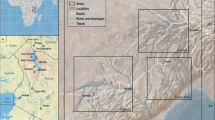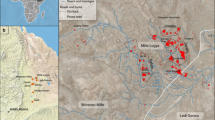Abstract
Using data from previous research on Quercus sect. Heterobalanus, the coexistence approach to Xixabangma and Namling fossil sets, and altitudinal ranges of vegetation presented by fossil floras, a review and reevaluation have been made of existing theories on the uplift of the Himalayas, especially the palaeoaltitudes of Xixabangma and Namling in Tibet. The Xixabangma fossil set has a palaeoaltitude range of 2500–3500 m, and has risen 2200–3400 m since the Pliocene. The lower and upper assemblages of the Miocene Namling had palaeoaltitudes of 2500–3000 m and 2800–3000 m, respectively. Therefore, Namling has risen at least 1300 m since the Miocene, thereby challenging some existing theories that suggest Namling has been static since the Miocene.
Similar content being viewed by others
References
Xu R, Tao J R, Sun X J. On the Discovery of a Quercus semicarpifolia Bed in Mount Xixabangma and its Significance in Botany and Geology. Act Bot Sin (in Chinese), 1973, 15(1): 103–119
Li J J, Wen S X, Zhang Q S, et al., A discussion on the period, amplitude and type of lift of Qinghai-Xizang Plateau. Sci Sin (in Chinese), 1979, 22(11): 1314–1328
Li J J, Fang X M, Ma H Z, et al. Geomorphologic and environmental evolution in the upper reaches of Yellow River during the Late Cenozoic. Sci China Ser D-Earth Sci, 1996, 26(4): 316–322
Li J J, Fang X M, Pan B T, et al. Qinghai-Tibetan Plateau violent uplift and influence upon circumjacent environment in Late Cenozoic. Quaternary Sci (in Chinese), 2001, 21(5): 381–390
Coleman M, Hodges K. Evidence for Tibetan Plateau uplift before 14 Myr ago from a new minimum age for east-west extension. Nature, 1995, 374: 49–52
Spicer R A, Harris N B W, Widdowson M, et al. Constant elevation of southern Tibet over the past 15 million years. Nature, 2003, 421: 622–624
Tapponnier P, Xu Z Q, Roger F, et al. Oblique stepwise rise and growth of the Tibetan Plateau. Science, 2003, 294: 1671–1677
Guo Z T, Ruddiman W F, Hao Q Z, et al. Onset of Asian desertification by 22 Myr ago inferred from loess deposits in China. Nature, 2002, 416: 159–163
Li J J, Fang X M. Uplift and environmental change of Qinghai-Tibetan Plateau. Chin Sci Bull, 1998, 43(15): 1569–1574
Shi Y F, Li J J, Li B Y, et al. Uplift of the Qinghai-Xizang (Tibetan) Plateau and East Asia environmental change during late Cenozoic. Acta Geograp Sin (in Chinese), 1999, 54(1): 10–21
Harrison T M, Copeland P, Kidd W S F, et al. Raising Tibet. Science, 1992, 255: 1663–1670
Rea D K, Snoeckx H, Joseph L H, Late Cenozoic eolian deposition in the North Pacific: Asian drying, Tibetan uplift, and cooling of the Northern Hemisphere. Paleoceanography, 1998, 13: 215–224
Shi Y F, Li J J, Li B Y, et al. Uplift and environmental evolution of Qinghai-Xizang (Tibetan) plateau. In: Sun H L, Zheng D. eds. Formation, Evolution and Development of Qinghai-Xizang (Tibetan) Plateau (in Chinese). Guangzhou: Guangdong Science & Technology Press, 1998. 73–138
Zheng D. eds. Formation, Environment and Development of Qinghai-Xizang (Tibetan) Plateau (in Chinese). Shijiazhuang: Hebei Science & Technology Press, 2003
Shi Y F, Liu D F. Preliminary report of scientific investigation on Mount Xixabangma. Chin Sci Bull (in Chinese), 1964, 10: 928–938
Fang X M, Li J J. The stages of the plateau uplift. In: Zhang D. eds. Formation, Environment and Development of Qinghai-Xizang (Tibetan) Plateau (in Chinese). Shijiazhuang: Hebei Science & Technology Press, 2003: 37–47
Skiger B, Porter S. Physical Geology. New York: John & Wiley, 1987: 256–259
Kroon D, Steen T N F, Truoelstra S R. Onset of the uplift of the Qinghai-Xizang Plateau. Quat Sci Rev, 1991, 10: 479–483
Quade J, Cerling T E, Bowman J R. Development of Asian Monson revealed by marked ecological shift during the latest Miocene in Northern Pakistan. Nature, 1989, 342: 163–166
Quade J, Cerling T E. Expansion of C4 grasses in the late Miocene of Northern Pakistan: evidence from stable isotopes in paleosols. Paleogreogr Paleogclimatol Paleoecol, 1995, 115: 91–116
Guo Z T, Peng S Z, Hao Q Z, et al. Origin of the Miocene-Pliocene Red-Earth formation at Xifeng in northern China and implication for paleoenvironments. Paleogeogr Paleoclimatol Paleoecol, 2001, 170: 11–26
Sun X J, Wang P X. How old is the Asian monsoon system?—Palaeobotanical records from China. Palaeogeogr Palaeoclimatol Palaeoecol, 2005, 222: 181–222
Kutzbach J E, Prell W L, Ruddiman W F. Sensitivity of Eurasian climate to surface uplift of the Tibetan Plateau. J Geol, 1993, 101: 177–190
Kutzbach J E, Ruddiman W F, Prell W L. Possible effects of Cenozoic uplift and CO2 lowering on global and regional hydrology. In: Rudiman W F. ed. Tectonic Uplift and Climate Change. New York: Plenum Press, 1997, 149–170
An Z S, Kutzbach J E, Prell W L, et al. Evolution of Asian monsoons and phased uplift of the Himalaya-Tibetan Plateau since late Miocene times. Nature, 2001, 411: 62–66
Zhou Z K, Pu C X, Chen W Y. Relationship between the distributions of Quercus sect. Heterobalanus (Fagaceae) and uplift of Himalayas. Adv Earth Sci (in Chinese), 2003: 18(6): 884–889
Zhou Z K. A taxnomical revision of fossil evergreen sclerophyllous oaks from China. Act Bot Sin (in Chinese), 1992, 34(12): 54–61
Zhou Z K. Fossil history of Quercus. Act Bot Yun (in Chinese), 1993, 15(1): 21–23
The Writing Group of Cenozoic Plant in China. Fossil Plants of China Vol. 13. Cenozonic Plants from China (in Chinese). Beijing: Science Press, 1978. 42–57
Tao J R, Zhou Z K, Liu Y S. The evolution of the Late Cretaceous-Cenozonic Flora in China (in Chinese). Beijing: Science Press, 2000. 6–72
Menitsky L L. Oaks of Asia. Moscow: Leningosed Sciences, 1984, 1–119
Li J Q, Guo Y S, Li Q, et al. Investigation report about life history diversities of sclerophyllous oaks in Tibet. J Beijing Forestry University (in Chinese), 1996, 18(1): 94–97
Yang Q Z. The characteristics and classification of oak durisilvae in the Himalayan region of China. Acta Phytoecol Geobotanica Sin (in Chinese), 1990, 14(3): 197–211
Li H M, Guo S X. The Miocene flora Nanmuling of Xizang. Acta Palaeont Sin (in Chinese), 1976, 15(4): 598–609
Huang C J, Zhang Y T, Hsu Y C, et al. Fagaceae. In: Chen H Y, Huang C J. eds. Flora of China. Vol. 14 (in Chinese). Beijing: Science Press, 1998, 213–332
Huang C J, Zhang Y T, Barthlomeaw R. Fagaceae. In: Wu Z Y, Raven P. eds. Flora of China. Vol.14. Beijing: Science Press, St. Louis: Missouri Botanical Garden Press, 1999. 314–380
Hsu Y C, Jen X W. Fagaceae. In: Wu Z Y. ed. Flora of Tibet Vo. 11 (in Chinese). Beijing: Science Press, 1983, 485–500
Ching R C, Wu S K. Selaginellaceae. In: Wu Z Y. ed. Flora of Tibet. Vol. 11 (in Chinese). Beijing: Science Press, 1983. 18–27
Ching R C, Wu S K. Pteridiaceae. In: Wu Z Y. ed. Flora of Tibet. Vol. 11 (in Chinese). Beijing: Science Press, 1983. 66–73
Ching R C, Wu S K. Polypodiaceae. In: Wu Z Y. ed. Flora of Tibet. Vol.11 (in Chinese). Beijing: Science Press, 1983. 291–340
Wang Z, Fang C F, Zhao S D, et al. Salicaceae. In: Wu Z Y. ed. Flora of Tibet. Vol.11 (in Chinese). Beijing: Science Press, 1983. 412–470
Li P C. Betulaceae. In: Wu Z Y. ed. Flora of Tibet. Vol.11 (in Chinese). Beijing: Science Press, 1983. 474–484
Fu L K. Ulmaceae. In: Wu Z Y. Flora of Tibet. Vol. 11 (in Chinese). Beijing: Science Press, 1983. 501–509
Ming T L, Fang R C, Huang S H. Ericaceae. In: Wu Z Y. ed. Flora of Tibet Vol. 13 (in Chinese). Beijing: Science Press, 1986. 552–732
Li P C, Ni Z C. Leguminaceae. In: Wu Z Y ed. Flora of Tibet. Vo.12 (in Chinese). Beijing: Science Press, 1985. 701–907
Wu C Y, Ding T Y. Seed Plants of China (CD). Kunming: Yunnan Science & Technology Press, 1998
Mosbrugger V, Utescher T. The coexistence approach-a method for quantitative reconstructions of Tertiary terrestrial palaeoclimate data using plant fossils. Palaeogeogr Palaeoclimatol Palaeoecol, 1997, 134: 61–86
Jin Z Z. Hard evergreen broad-leaf forests. In: Wu Z Y. ed. Flora in China (in Chinese). Beijing: Science Press, 1981. 356–363
Li W H. Main types and characters of Tibeten forests. In: Li W H. ed. Tibeten Forests (in Chinese). Beijing: Science Press, 1985. 38–152
Chen W L. Forests. In: Scientific work group of Qinghai-Xizang Plateau investigation, eds. Flora in Tibet (in Chinese). Beijing: Science Press, 1988. 98–147
The Working Group of Flora in Sichuan. eds. Flora in Sichuan (in Chinese). Chengdu: Sichuan People’s Press, 1980. 109–127
Jin Z Z. The sclerophyllous evergreen broad-leaf forest. In: Wu Z Y, Zhu Y C, eds. Flora in Yunnan (in Chinese). Beijing: Science Press, 1987. 382–396
Zhou Z K, Wilkinson H, Wu Z Y. Taxonomical and Evolutionary implications of the leaf anatomy and architecture of Quercus L. subg. Quercus from China. Cathaya, 1995, 7:1–34
Wolfe J A. A method for obtaining climate parameters from leaf assemblages. US Geol Surv Bull, 1993, 2040: 71
Wolfe J A, Schorn H W, Forest C E, et al. Paleobotanical evidence for high altitudes in Nevada during the Miocene. Science, 1997, 276: 1672–1675
Gřubb P J. Interpretation of the “Massenerhebung effect on tropical mountains”. Nature, 1971, 229: 44–45
McCain C M. Elevational gradients in diversity of small mammals. Ecology, 2005, 86(2): 366–372
Fang J Y, Guo Q H, Liu G H. Distribution patterns of Chinese beech (Fagus L.) species in relation to topography. Act Bot Sin (in Chinese), 1999, 41(7): 766–774
Xu R. On the palaeobotanical evidence for continental drift and Himalayan uplift. Palaeobot, 1978, 25: 131–142
Liu D S, Zhang X S. The impact of plateau uplifting on surrounding areas. In: Sun H L, Zheng D, eds. Formation, Evolution and Development of Qinghai-Xizang (Tibetan) Plateau (in Chinese). Guangzhou: Guangdong Science & Technology Press, 1998. 179–230
Royer D L, Wilf P, Janesko D A, et al. Correlations of climate and plant ecology to leaf size and shape: Potential proxies for the fossil record. Am J Bot, 2005, 92(7): 1141–1151
Huff P M, Wilf P, Azumah E J. Digital future for paleoclimate estimation from fossil leaves? Preliminary results. Palaios, 2003, 18(3): 266–274
Author information
Authors and Affiliations
Corresponding author
Additional information
Supported by the National Natural Science Foundation of China (Grant Nos. 40332021, 30670159) and Wu Zhengyi’s Splendidly Contributing Award of Yunnan Province (Grant No. KIB-WU-2001-01)
About this article
Cite this article
Zhou, Z., Yang, Q. & Xia, K. Fossils of Quercus sect. Heterobalanus can help explain the uplift of the Himalayas. CHINESE SCI BULL 52, 238–247 (2007). https://doi.org/10.1007/s11434-007-0005-7
Received:
Accepted:
Issue Date:
DOI: https://doi.org/10.1007/s11434-007-0005-7




